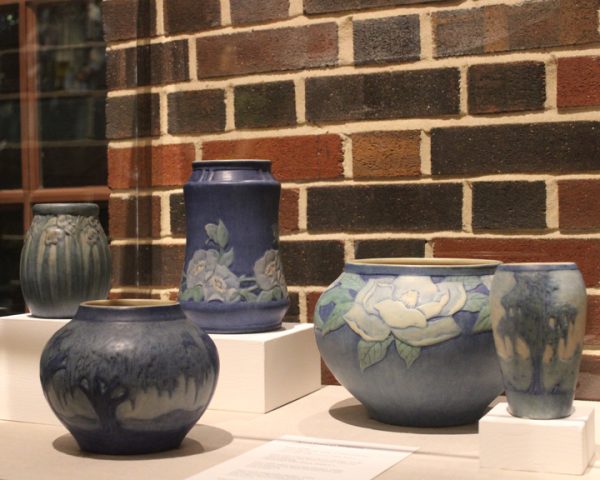
As an art history lover, I’m always on the lookout for art in the wild. When walking to class past the Newcomb Art Museum, the beautiful pottery in the glass cases immediately caught my eye. These casually displayed masterpieces are just a taste of Newcomb’s rich artistic history. Art might not be the first thing that comes to mind when people think about Tulane, but it has played an undeniable part in shaping its history and legacy.
In 1886, Josephine Louise Newcomb donated a generous sum to Tulane University in the name of her late daughter. This money helped establish H. Sophie Newcomb College, the first coordinate women’s college in the United States. Out of this progressive initiative to provide Southern women with liberal arts education, a bountiful artistic tradition flourished. Possibly the most well-known of these artistic developments was Newcomb Pottery, a nationally recognized program that grew out of the art school. This program, started in 1895, was part of the American arts and crafts movement which emphasized handmade arts in a world of increasing industrialization during the turn of the century.
Newcomb Pottery was originally directed by Ellsworth and William Woodward, who had previously started the New Orleans Art Pottery company, which closed shortly after its opening. Despite its association with the women’s college, the company hired male potters to throw the vessels, as it was considered unladylike to sit at a potter’s wheel. Joseph Fortune Meyer was the first potter the Pottery hired, and he remained until 1927. The role of the women was to decorate and glaze the pottery. This was done meticulously by hand, giving each piece a unique, one-of-a-kind design.
Mary G. Sheerer, who graduated from the Art Academy of Cincinnati, taught the women of Newcomb Pottery. Her influence prompted the flora and fauna motifs that are so emblematic of Newcomb Pottery. Sheerer encouraged students to study the native flora of the south and recreate it within their works, which were made from local clay. The style, along with the mark of the letter N inside a C — representing the word “Newcomb” — gives the pieces their signature look.
The Newcomb Pottery hired women educated in pottery skills through the Newcomb Art department after they had graduated. The program offered employment to young women at a time when working women were not the norm and promoted using business to endorse art for the development of independent women. As Newcomb Art students, the women were originally required to pay for the materials for the pieces made, recouping the profits through sales. However, by the early 20th century, the school created a fund to pay for the materials. By 1902, the Pottery had outgrown the Newcomb Art building and erected a new facility at 2828 Camp Street, designed by New Orleans architect Rathbone de Buys.
Newcomb Pottery was sold across the country and was praised for its artistry internationally. In 1900, Newcomb Pottery won a bronze medal in the Exposition Universelle in Paris. Just seven years later, the Pottery won gold at the Jamestown Ter-Centennial Exposition in Norfolk, Virginia.
Eventually, faculty added other mediums such as jewelry-making, bookbinding and metalworking to the curriculum. While local flora and fauna remained a staple in Newcomb Pottery’s designs, the styles and techniques changed throughout the years. Originally, the Pottery used a glossy-finish glaze on their pieces, but around 1910, new glazes became available and the artists quickly adopted them. This new look was profitable, but increased sales resulted in higher demand and less opportunity for creativity and innovation. The products of the Pottery became more standardized, and it became less attractive for young women to join. After unsuccessful debuts of modern, art deco designs in the 1920s, the success of the Newcomb Pottery started to decline. By 1940, the new administration closed the Pottery as a business and refocused their efforts on education.
Although the Pottery isn’t around today, it remains a pivotal piece of history for the Newcomb-Tulane College that we know and love. Newcomb Pottery artwork is still displayed across the country in traveling exhibitions to this day, and there are also many pieces on display on campus for the public to see. Take a trip to the Newcomb Institute on the third floor of the Malkin Sacks Commons, the entryway of the Woldenberg Art Center or around the Goldring/Woldenberg Business Complex to see these important pieces of the university’s history for yourself and remember the legacy of our trailblazing Newcomb predecessors.




Leave a Comment